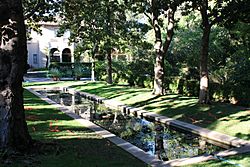Blake Garden (Kensington, California) facts for kids
Quick facts for kids Blake Garden |
|
|---|---|

Blake Garden
|
|
| Lua error in Module:Location_map at line 420: attempt to index field 'wikibase' (a nil value). | |
| Type | Public |
| Location | Kensington, California, United States |
| Nearest city | Kensington, California |
| Area | 10.6 acres (4.3 ha) |
| Created | 1957 by |
| Status | Open year round |
| Website | Official Blake Garden website: http://blakegarden.ced.berkeley.edu/ |
Blake Garden is a beautiful 10.6-acre (about 4.3 hectares) public garden in Kensington, California, United States. It's like a living classroom for students studying landscape architecture and Environmental Planning at the University of California, Berkeley. The garden is also home to Blake House, which used to be where the President of the University of California lived. You can visit Blake Garden for free on weekdays!
Contents
The Story of Blake Garden
Blake Garden has an interesting history. The Blake family first lived in Berkeley, where the Memorial Stadium is now. When the stadium was built, two new homes were made in the Kensington hills. One was for Anson Blake, which is now Blake Garden. The other was for Edwin Blake, which is now a monastery.
How the Garden Started
Anson and Anita Blake gave the garden to the University of California, Berkeley's Landscape Architecture Department in 1957. After Anita Blake passed away in 1962, the university officially owned the garden. A few years later, Blake House became the official home for the University of California President until 2009.
Who Designed the Garden?
Mrs. Blake's sister, Mabel Symmes, designed the garden. She studied landscape architecture at the same university and graduated in 1914. Her original plan for the garden was very thoughtful. She made sure the design worked well with the land.
Special Garden Areas
Many parts of Mabel Symmes's original design can still be seen today.
- Pink and Yellow Gardens: These gardens have a cool grotto, which is like a small cave, inspired by an old Italian villa.
- Reflecting Pool: This pool was part of a clever system to use underground water.
- Redwood Canyon: This area has redwood trees that came from the Blake family's other properties. It follows a natural waterway.
Restoring the Australian Hollow
The original plan also showed a lake in an area called the Australian Hollow. This part of the garden had a lot of natural water underground. In 2010, university students, volunteers, and garden staff worked together to turn this area into a native wetland. Now, this wetland is a home for Pacific chorus frogs and many different kinds of birds.
Exploring Blake Garden's Plants
Blake Garden has many different types of plants from all over the world.
Mediterranean Garden
On the western side of Blake House, you'll find the Mediterranean Garden. This area shows off plants that don't need much water. These plants come from places around the world that have a Mediterranean climate, which means they have warm, dry summers and mild, wet winters.
Cottage Garden
The Cottage Garden is a lovely spot filled with roses, flowers for cutting, vegetables, and herbs. It's a great example of a traditional garden style.
The Square
In The Square, there's a pond full of water lilies. The garden beds around it are bursting with perennial plants that also don't need a lot of water. Perennial plants are those that live for more than two years.
Event Lawn
The Event Lawn and the areas around it are another example of smart gardening that saves water. This shows how beautiful a garden can be even when using less water.
Nature and Sustainability
Blake Garden is home to almost 1500 different kinds of plants! You can also spot over fifty types of birds, along with raccoons, frogs, salamanders, and sometimes even a fox.
Organic Practices
The entire garden is organic. This means they don't use harmful chemicals. They use many sustainable practices to help the environment, such as:
- Composting: They use four different ways to make compost, which is like natural fertilizer from old plants.
- Rainwater Harvesting: They collect rainwater to use for the plants.
- Honeybees: They have hives of honeybees, which are important for pollinating plants.
Create with Nature Zone
The Create with Nature Zone is a special place for visitors of all ages. Here, you can experiment and build things using natural materials found right in the garden. It's a fun way to connect with nature!
See also
 In Spanish: Jardín Blake para niños
In Spanish: Jardín Blake para niños

